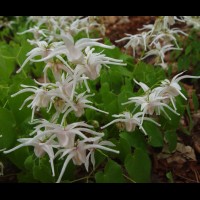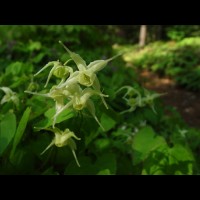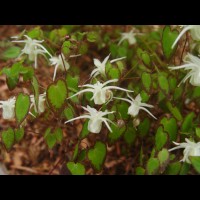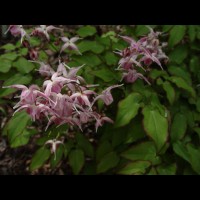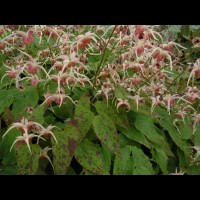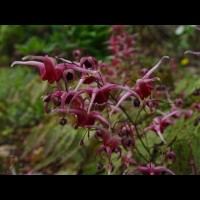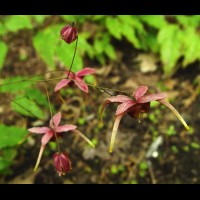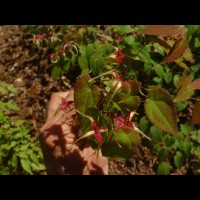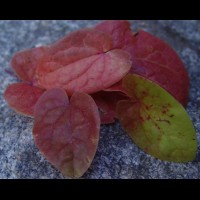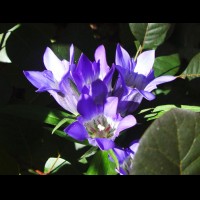Epimedium davidii "Robust Forms"
E. davidii “Robust Form” (Several clones)
Like many species, E. davidii varies from one location to another. In 1999 Darrell helped to identify Epimediums purchased from China by a local nursery. Overall they were more robust and vigorous than any of the clones that he had collected in China, with flower stems from 18-24” high bearing the typical bright yellow blooms. They also had bolder evergreen foliage than any we have grown. The clones we offer have attractively red-mottled spring leaflets. Spreads slowly by occasional 4-8” rhizomes to form a mass 2’ wide in about 5 years under good growing conditions.
Epimedium diphyllum Cc. 940545
Epimedium diphyllum (Cc. 940545)
Only 5 to 10" tall in bloom, produces dainty, spur-less white, bell-shaped flowers over an extended period in spring for a very delicate effect. One of several clones imported from Japan. Semi-evergreen. Not available this year.
Epimedium diphyllum 'Nanum'
E. diphyllum ‘Nanum’ (Cc. 950054)
A sparkling gem at only 2-4" tall at first bloom, and covered in white bell-shaped flowers. Ultimately reaches 8" high. Ideal for shady rock gardens, path edges or troughs.
Epimedium dolichostemon
Epimedium dolichostemon Og. 81010 (Cc. 980078)
Narrow, evergreen, medium-sized arrow-shaped leaflets, heavily mottled with burgundy in the spring. Each small uniquely shaped flower has beautiful, reflexed, white inner-sepals and red petals with short, strongly curved spurs. 18” tall. In 1998, Robin White generously shared a blooming plant.
Darrell was awestruck the first time he saw slides of this clone. Lois Himes, garden assistant to Harold Epstein, took them of a plant exhibited by Robin White when she accompanied Harold to a 1995 Royal Horticultural Society show in London. It is far superior to the Ogisu clone (Og. 81011-- which is unfortunately terribly virused) making the rounds in the U.S.
Epimedium grandiflorum 'Cranberry Sparkle'
E. grandiflorum ‘Cranberry Sparkle’ (Cc. 950162)
***2002 Cobblewood™ Introduction***
Darrell’s friend Don Elick spent five days in April 1995 on a whirlwind dash through southern Japan searching for select forms of wild Epimediums that might prove useful in Darrell’s breeding program. This was his most incredible find with large, rich cranberry flowers held out horizontally on 6” stems. The small leaflets are flushed bronze in spring. Very, very late to emerge and one of the last grandiflorums to bloom. 10” tall.
Epimedium grandiflorum 'Princess Susan'
E. grandiflorum ‘Princess Susan’ (Cc. 960044)
***1999 Cobblewood Introduction***
A beautiful, large-flowered selection from Harold Epstein’s garden, named after his daughter. Flowers are a crisp contrast of cherry-rose inner-sepals and pure white petals/spurs against small, bright green leaflets. Foliage grows more horizontally than that of other Epimediums. 8” in bloom with a second growth flush to 13”. A late bloomer.
Epimedium grandiflorum 'Sirius'
E. grandiflorum ‘Sirius’ (Cc. 920024)
A 1990 Dick Weaver introduction, ‘Sirius’ originated as a seedling in Harold Epstein’s garden. The large and delicate palest of pink flowers float above small, distinctively light green leaflets. Often only 5” tall in bloom, with a second flush of growth to 10”. Blooms at the "tale-end" of the Epimedium season.
Epimedium grandiflorum 'Yellow Princess'
E. grandiflorum ‘Yellow Princess’ (Cc. 940547)
***2000 Cobblewood Introduction***
Simply beautiful, the small leaflets of this form a low 5-1/2” mass with large, clean, light yellow flowers held aloft on stems to 10”. The spent flower stems are eventually engulfed by a second growth flush. From high elevations in Japan, it emerges late and is one of the last of E. grandi
Epimedium grandiflorum var. coelestre 'Alpine Beauty'
E. grandiflorum var. coelestre ‘Alpine Beauty’ (Cc. 950058)
***2000 Cobblewood Introduction***
Extremely rare in the wild and in cultivation, this is the only Epimedium that grows at montaine heights. Beauti
Epimedium grandiflorum var. higoense 'Bandit'
E. grandiflorum var. higoense ‘Bandit’ (Cc. 950057)
Although Darrell has obtained this clone from several sources, he has traced it back to a 1981 We Du Nursery purchase from Japan. It is very different from the clone he got from them eleven years later. After many years of trialing, he named it in 2000 as it is very distinct and has the most striking, dark purple band around the edge of each small leaflet as it emerges in spring. Medium-sized, creamy-white flowers cover the plant at 6” tall, with a second flush of banded leaves to 10” as the older leaves green up. A customer favorite.
Epimedium grandiflorum var. higoense 'Confetti'
E. grandiflorum var. higoense ‘Confetti’ (Cc. 960144)
***2007 Cobblewood™ Introduction***
A marvel of texture. Each leaf is composed of up to 50 small leaflets, and most are uniquely speckled, flecked and splotched with dark purple in spring. Our leafiest clone of Epimedium by far. 7” high in bloom, bearing hordes of elegantly crafted, medium-sized white flowers. All flower parts are thin and tapered, the whole giving the effect of delicate spiders floating over the foliage.
Epimedium grandiflorum var. higoense 'Saturn'
E. grandiflorum var. higoense ‘Saturn’ (Cc. 920023)
A 1991 We Du introduction named by Dick Weaver for the maroon band that circles each tiny spring leaflet. Only 4 to 5” tall in bloom, the second growth flush may reach 8”. Medium-sized, creamy-white flowers. Foliage provides a fine-textured effect in the garden. Later to bloom than most grandiflorums.
Epimedium sp. nov. 'Spine Tingler'
Epimedium sp. nov. 'Spine Tingler' (Cc. 001764)
***2008 Cobblewood Introduction***
A form of an as yet, unnamed Chinese species collected by Darrell Probst in Sichuan Province. The long, narrow (1”) spiny leaflets emerge with a light chocolate wash in early spring. Later long, overarching stems of large lemon-yellow spidery flowers float over a mass of exceptional evergreen foliage. To 10".
5Epimedium sp. nov. 'Tarantula'
Epimedium sp. nov. ‘Tarantula’ Cc. 012418
This clone has the narrowest leaves of any Epimedium in our entire collection. Delicate hair-like spines, run the edge of each leaf in a zig-zag pattern. Bears long, sprays of soft yellow flowers. Leaflets range in size from .25 to 5/8” across, and 3-4” in length, sporting an occasional simple leaf.
Epimedium trifoliatobinatum
Epimedium trifoliatobinatum (Cc. 950046)
Found in only a few areas on Shikoku, Japan, it is treated as a valid species by Prof. W. T. Stearn. However, Darrell Probst thinks that it looks very much like a stabilized, true-breeding form of E. x youngianum, as the area to which it is endemic is within a region where E. grandiflorum and E. diphyllum naturally overlap. This clone is only 5” tall in bloom with a second growth flush to 9” tall. Medium-sized white flowers have spurs like E. grandiflorum but are smaller and in proportion to the overall diminutive habit of this clone. Small, rounded 1" wide, bronzed spring leaflets expand to green with maroon flecks.
Epimedium 'Buttered Popcorn'
Epimedium ‘Buttered Popcorn’ (Cc. 960040)
***2001 Cobblewood Introduction***
This spontaneous hybrid between E. x setosum and E. davidi appeared in Harold Epstein’s garden in 1996. The plentiful, sunshine-yellow flowers bloom in long, thin sprays, just above the foliage to 15”. The charming small, yellow "box-shaped" flowers have a flared cup with short, sassy spurs and a red rim around the inner-sepals.
Small to medium-sized evergreen leaflets form a mass 10” tall. The leaflets are similar to those of E. davidii, but are longer and narrower, becoming dark green or even black-purple in winter. Grows more vigorously in northern gardens than E. davidii, producing a larger clump in less time.
Epimedium 'Flame Thrower'
Epimedium ‘Flame Thrower’ (Cc 990619)
***2009 Cobblewood Introduction***
Cheerful cherry red and creamy yellow flowers dance above the foliage of this hybrid from Darrell Probst. The inner sepals have decorative undulations to their shape, resembling flames licking upwards from the top of the flower. This cross between deciduous and evergreen parent plants gives this hybrid both vigorous growth and deep green, spiny leaflets of good substance. Drought-tolerant.
Epimedium 'Making Waves'
Epimedium ‘Making Waves’ (Cc. 031433)
A 2003 Collector’s Nursery introduction, named for its exceptional wavy-edged leaflets with a soft, irregular maroon band in spring. Out-facing, long spurred mauve-pink flowers are accented with soft pink and held well above the foliage, on dark, nodding stems. Late blooming.
Epimedium 'Ninja Stars'
Epimedium ‘Ninja Stars’ (Cc. 030301) Plant Patent #29744P2
***2016 Cobblewood Introduction***
A vigorous hybrid of two as yet unnamed, handsome species with particularly nice foliage collected in Sichuan Province, China by Darrell Probst. Long, narrow, very evergreen spiny leaflets form a crown of foliage 10-12” tall. Long sprays of spidery sulphur-yellow flowers scatter above the foliage. The multi-branched, spreading rhizomes grow 4-6” per year. New leaflets display a light bronzy-pink on first and second growth flushes in spring.
Epimedium 'Pink Champagne'
Epimedium ‘Pink Champagne’ (Cc. 990618)
***2007 Cobblewood Introduction***
Perhaps the most all around beautiful Epimedium of those that Darrell has developed so far! Upright, heavy flowered panicles of pink and raspberry flowers float well above handsome, mottled foliage in spring. Medium pink sepals cap the top of each widely-arched spur. From the yellow spur tips that reveal their treasure of nectar, the color changes from white to a rich, berry pink, as if the cup was dipped in raspberry sorbet. Elongated, evergreen medium-sized arrow-shaped leaflets contrast purple mottling against a green background. A vigorous grower, it puts on an incredible show with occasional re-bloom if it is happy in its environment. 12" tall with flower stems reaching 16".
Epimedium 'Splish Splash'
Epimedium 'Splish Splash' (Cc. 150001)
This beauty is a 2013 Plant Delights Nursery introduction that is certainly worth of a place in the garden. The arrow-shaped spring leaflets are heavily mottled in rich mahogany during the cool spring weather. The dark green mottled foliage serves as a great background to show off the multitudes of clean white flowers. Up to 12" in bloom. Semi-evergreen.
Epimedium 'William Stearn'
Epimedium 'William Stearn' (Cc. 150004)
A hybrid from Robin White of the former Blackthorn Nursery in Hampshire, England. As one of the earliest "red" flowering epimediums, it was named for the late William Stearn who wrote the monograph on Epimediums in 1938 (revised in 2002 by Timber Press).
The arrow-shaped, semi-evergreen leaflets form a handsome clump, exhibiting reddish-brown mottling in the spring. Produces short, few-flowered stems of muddy red and yellow flowers. I have found it to be slow to establish in the garden. The foliage is its greatest asset, in my opinion.
Epimedium 'Windfire'
Epimedium ‘Windfire’ (Cc. 002114)
**2007 Cobblewood Introduction***
Wiry, black-red upright flower spikes rise above the foliage carrying large, canary yellow flowers with small, dark red sepals. The thin reflexed spurs give the flower a very elegant silhouette. Slightly spreading with an open habit, by rhizomes that grow 4” a year. Medium-sized semi-evergreen leaflets form a leafy, open base to 12”. Flower spikes to 20”.
Epimedium 'Yokihi'
Epimedium ‘Yokihi’ (Cc. 050030)
An outstanding late-blooming Japanese cross between E. davidii and E. grandiflorum ‘Yubae’, this clumping hybrid produces long arching 18” spikes of large spidery flowers. The dramatic flowers have a flared creamy yellow cup and long, slender spurs backed by short, bright reddish pink inner sepals. Medium green angular leaflets are flushed with bronzy red in spring. Semi-evergreen.
Epimedium x omeiense 'Akame'
E. x omeiense ‘Akame’ Og. 82001 (Cc. 970187)
(Synonyms: ‘Emei Shan’, ‘Rigoletto’)
Mikinori Ogisu collected this clone on Mt. Emei in Sichuan, which Professor Stearn used as the type specimen for his description of E. x omeiense. The brilliant blooms have cherry-red inner-sepals and bright orange and yellow spurs. The cup is most intensely colored and edged in yellow. Open flower sprays are held above large, dark, handsome, glossy sagittate evergreen leaves that sometimes turn maroon in fall. 12-15” tall. A showy late bloomer.
Epimedium x youngianum 'Freckles'
Epimedium x youngianum ‘Freckles’ (Cc. 950080)
***2000 Cobblewood Introduction***
'Freckles' is a seedling that appeared in Harold Epstein’s garden among a mass of ‘Milky Way’, an obvious parent. Large grandiflorum –like flowers with white inner-sepals are flushed and veined lavender with white spurs. Introduced for its pure flower colors, but named for its lively, small spring leaflets, generously speckled in purple. 7” in bloom to 18”.
Epimedium x youngianum 'Jenny Wren'
Epimedium x youngianum ‘Jenny Wren’ (Cc. 990568)
***2003 Cobblewood Introduction***
A dainty cultivar from the garden of John Marchacos, Berlin, CT. The small, dark green spring leaflets are speckled and splotched with burgundy against a softer purple wash like the markings of a tiny wren’s egg. Light, lavender-pink, medium-sized flowers stand perky and bright against the mottled foliage. 5” in bloom, to 12”. An early bloomer.
Epimedium x youngianum 'Little Shield'
Epimedium x youngianum ‘Little Shield’ (Cc. 950240)
***2004 Cobblewood Introduction***
Distinctive shield-shaped leaves are part of this plant’s allure. In spring a soft overlay of milky mocha covers the small to medium-sized leaves, heavily indented at the veins. 8” tall in bloom, with numerous, perky 3/4” white flowers held above the foliage. Spurs slightly longer than sepals. Semi-evergreen.
Epimedium x youngianum 'Otome'
E. x youngianum ‘Otome’ (Cc. 970066)
Another gem Ozzie Johnson purchased in Japan with small, spur-less white flowers flushed pink. The first flush of flowers starts at 5” with a second flush of medium-sized, rounded leaflets and some re-bloom to 10”. Semi-evergreen with reliable red/orange fall color. A sparse bloomer, the real appeal of this clone is the beautiful fall foliage.
Epimedium x youngianum 'Ruby Tuesday'
Epimedium x youngianum ‘Ruby Tuesday’ (Cc. 950085)
***2001 CobblewoodIntroduction***
Small and delicate, it begins to bloom at only 5” tall. After a second and third flush of foliage and flowers, it eventually reaches 14”, making it one of the latest blooming of Epimediums. Its small spring leaflets have a purple cast. Medium-sized flowers are rich, ruby-red with lighter pale rose to white spurs.
Gentiana scabra
Gentiana scabra
An easy to grow, robust species for sun or partial shade (more shade where summers are hot). Tolerates a wide variety of soil conditions; blooms July-October. Native to northern Asia and Japan, this variable species sports erect, leafy erect stems 8 -15” high. Violet-blue, tubular upright facing flowers with 4 pointed corolla lobes. These plants are selected seedlings.
Gentiana x 'True Blue'
Gentiana x ‘True Blue’ (Plant Patent #20433)
***2008 Cobblewood Introduction***
Forms a well-branched, upright, robust column 24-36" high, by 12-18" wide, with lance-shaped leaves and 2” tubular caerulean blue flowers from midsummer-early fall. Best in part shade to full sun (in the north).
Plant in well-drained sandy loam/loamy soils with consistent moisture. A Darrell Probst hybrid. Propagation prohibited.
Geranium maculatum 'Cobblewood Ghost'
Geranium maculatum ‘Cobblewood Ghost’
This dainty woodland native bears white 1.5” blooms for 6-7 weeks in May-early June. Native to the eastern U.S. and Canada. Grows best in part shade to full sun. If planted in some sun, the dark green palmate leaves turn brilliant scarlet in fall. 2’ high by 18” wide. Darrell found this clone (far superior to the more commonly offered ‘Hazel Gallagher’) growing wild in central Massachusetts. Will naturalize in the garden from seed.







